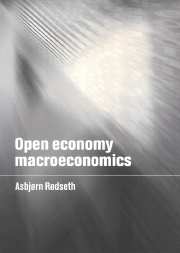Book contents
- Frontmatter
- Contents
- List of figures
- List of tables
- Preface
- List of standard symbols
- Introduction
- Part 1 Financial markets
- 1 The foreign exchange market
- 2 Portfolio choice, risk premia and capital mobility
- 3 Money
- 4 The monetary theory of the exchange rate
- Part 2 The open economy
- Part 3 Policy issues
- Appendixes
- Notes
- Bibliography
- Index
3 - Money
Published online by Cambridge University Press: 06 July 2010
- Frontmatter
- Contents
- List of figures
- List of tables
- Preface
- List of standard symbols
- Introduction
- Part 1 Financial markets
- 1 The foreign exchange market
- 2 Portfolio choice, risk premia and capital mobility
- 3 Money
- 4 The monetary theory of the exchange rate
- Part 2 The open economy
- Part 3 Policy issues
- Appendixes
- Notes
- Bibliography
- Index
Summary
In chapters 1 and 2 there were just two financial assets: one denominated in domestic currency, one denominated in foreign currency, and both interest bearing. This precluded a discussion of monetary policy proper. The interest rate was treated as an exogenous policy instrument. In the present chapter we also allow the central bank to make policy through adjusting the quantity of money. Nominal interest rates are then determined endogenously.
In section 3.1 we extend the simple portfolio model from section 1.4 to include money. The model allows us to discuss various strategies for monetary policy in the open economy. It is used in later chapters as a representation of the financial side of the economy. In section 3.2 we take a closer look at the demand for money. This leads to a discussion of competition between currencies and the use of foreign currency for transaction purposes. In section 3.3 we extend the portfolio model further by including banks and wind up with some conclusions about money supply targets. The final section (3.4) looks at the role of foreign exchange reserves when the exchange rate is fixed and at two variants of fixed rate systems: currency boards and target zones.
- Type
- Chapter
- Information
- Open Economy Macroeconomics , pp. 63 - 96Publisher: Cambridge University PressPrint publication year: 2000



